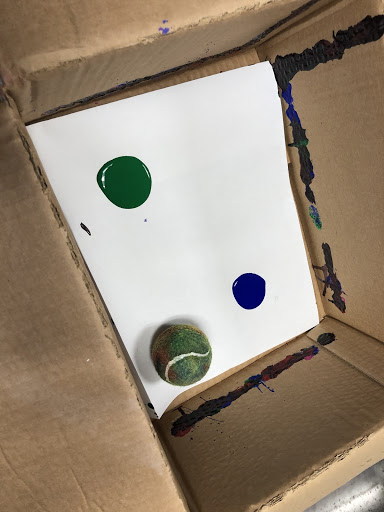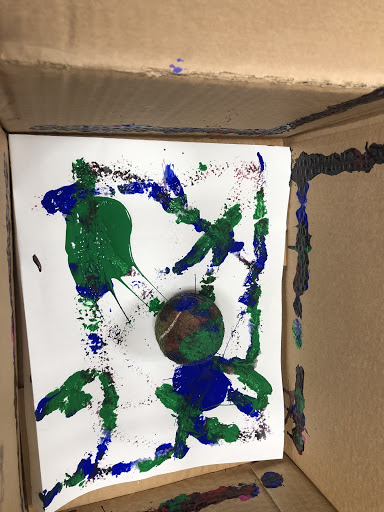
Students will be introduced to one of the basic elements of art—line—by analyzing types of lines used in various works of art to help students understand how artists use line to convey movement and mood. They will then create an abstract line art piece based on an activity they enjoy to do or watch.

Frank Stella
American, born 1936
Jarama II, 1982
mixed media on etched magnesium, 319.9 x 253.9 x 62.8 cm (125 15/16 x 99 15/16 x 24 3/4 in.)
National Gallery of Art, Gift of Lila Acheson Wallace
If this painting could move, would it move quickly or slowly? Is there something about the lines that make you think so?
Line is a mark made using a drawing tool or brush. There are many types of lines: thick, thin, horizontal, vertical, zigzag, diagonal, curly, curved, spiral, etc. and are often very expressive. Lines are basic tools for artists—though some artists show their lines more than others. Some lines in paintings are invisible—you don't actually see the dark mark of the line. But they are there, shown in the way the artist arranges the objects in the painting.
Artist Frank Stella is a racing fan. This metal relief painting, Jarama II, is named after an automobile racetrack outside Madrid, Spain. Here, Stella used winding, curving strips of metal painted in bright, dynamic colors to forcefully carry the motion and excitement of professional racing.
Lines in art express different things. View the slideshow below and have students answer the questions beneath each image:
Slideshow: Exploring Lines in Works of Art
previous slides
Roy Lichtenstein
American, 1923–1997
Leo Castelli Gallery (publisher)
Chiron Press (printer)
Brushstroke, 1965
color screenprint on heavy, white wove paper, 58.4 x 73.6 cm (23 x 29 in.)
Corlett/Fine 1994, Vol. II, no. 5
National Gallery of Art, Gift of Roy and Dorothy Lichtenstein
What type of line is this?
Now, look closely at these lines. Which group of words best describes them?
(1) Calm, serious, quiet
(2) Energetic, fun, dynamic

Charles Sheeler
American, 1883–1965
Classic Landscape, 1931
oil on canvas, 63.5 x 81.9 cm (25 x 32 1/4 in.)
National Gallery of Art, Collection of Barney A. Ebsworth
What types of lines do you see?
Where do you see the following:
Now, look closely at these lines. Which group of words best describes them?
(1) Solid, serious, organized, planned
(2) Silly, energetic, dynamic, in motion, chaotic

Joan Miró
Spanish, 1893–1983
The Farm, 1921–1922
oil on canvas, 123.8 x 141.3 x 3.3 cm (48 3/4 x 55 5/8 x 1 5/16 in.)
National Gallery of Art, Gift of Mary Hemingway
What types of lines do you see?
Where do you see the following:
Look closely at these lines. Which group of words best describes them?
(1) Busy, topsy turvy, active
(2) Serious, calm, quiet

Morris Louis
American, 1912–1962
Beta Kappa, 1961
acrylic on canvas, 262.3 x 439.4 cm (103 1/4 x 173 in.)
National Gallery of Art, Gift of Marcella Louis Brenner
What types of lines do you see?
How is this painting different than the previous ones?
Look closely at these lines. Which group of words best describes them?
(1) In motion, festive, fun
(2) Calm, sleepy, still

Henri Matisse
French, 1869–1954
Woman Seated in an Armchair, 1940
oil on canvas, 54 x 65.1 cm (21 1/4 x 25 5/8 in.)
National Gallery of Art, Given in loving memory of her husband, Taft Schreiber, by Rita Schreiber
What types of lines do you see?
Where do you see the following:
Look closely at these lines. Which group of words best describes them?
(1) Motion, festive, fun
(2) Calm, sleepy, still

Winslow Homer
American, 1836–1910
Breezing Up (A Fair Wind), 1873-1876
oil on canvas, 61.5 x 97 cm (24 3/16 x 38 3/16 in.)
National Gallery of Art, Gift of the W. L. and May T. Mellon Foundation
Can you find the hidden lines in this painting? This painting of a fast-moving sailboat is full of diagonal lines. Why? Artists use diagonals to show energy and movement. Diagonals also lead the viewer into the painting. Try to imagine the boat without the diagonals, sitting flat on the water—horizontally—with the mast going straight up—vertically—into the sky. Would the boat be moving, or sitting still, without the diagonals?
Now, compare this boating scene to the next slide image.

Fitz Henry Lane
American, 1804–1865
Lumber Schooners at Evening on Penobscot Bay, 1863
oil on canvas, 62.5 x 96.8 cm (24 5/8 x 38 1/8 in.)
National Gallery of Art, Gift of Mr. and Mrs. Francis W. Hatch, Sr.
Is this boat moving fast or slow? It looks like it is standing still. Does the water seem calm or churning? How hard is the wind blowing? (No sails up = very little wind!) Are there any diagonal lines in this painting? (Very few—mostly straight lines here, vertical and horizontal. Without diagonal lines, the artist created a quiet, calm scene with a slow moving boat.)
next slidesStudents will select an activity they enjoy watching or participating in that involves movement such as playing a sport, dancing, climbing a tree, biking, jumping rope, etc. They will list adjectives that describe both the activity and feelings they have while doing or viewing this activity. Then, students will write next to each adjective what type of line and color would reflect this activity best. For example, watching a ballet may be soft, thin, wavy lines in pastel colors, while jumping rope may be thick, zigzag lines in bold hues. Using Stella’s Jarama II as their inspiration, students will create an abstract line art piece in a medium of their choice that evokes the feeling of their activity. Remind students that selection of media is very important; markers create a much bolder impression than watercolors so they should think about the whole picture they wish to depict.
To accommodate visual impairments, students can use yarn and glue to create their abstract line drawings. Students can draw with glue onto a piece of paper, and then lay different types and lengths of yarn to create a raised surface drawing.
An alternative to accommodate motor control differences would be to create an abstract line drawing using a box, balls, and tempera paint. Students would place a piece of paper inside a long box, and squeeze 3-4 quarter-size amounts of tempera paint in different colors onto the paper. Students would then use balls of varying sizes and roll the balls through the paint, trying different speeds, to create lines.

previous thumbnail set
 Line Drawing with Balls /content/dam/ngaweb/Education/learning-resources/lessons-activities/elements-of-art/EA-Line-3.jpg Place a piece of paper inside a box, and put 3-4 quarter-size amounts of tempera paint in different colors on the paper.
Line Drawing with Balls /content/dam/ngaweb/Education/learning-resources/lessons-activities/elements-of-art/EA-Line-3.jpg Place a piece of paper inside a box, and put 3-4 quarter-size amounts of tempera paint in different colors on the paper. Line Drawing with Balls /content/dam/ngaweb/Education/learning-resources/lessons-activities/elements-of-art/EA-Line-Photo-2.jpg Pick balls of various sizes and have students roll the balls through the paint to create lines.
Line Drawing with Balls /content/dam/ngaweb/Education/learning-resources/lessons-activities/elements-of-art/EA-Line-Photo-2.jpg Pick balls of various sizes and have students roll the balls through the paint to create lines.Line Drawing with Balls
Place a piece of paper inside a box, and put 3-4 quarter-size amounts of tempera paint in different colors on the paper.
Students will then post their finished works of art for class discussion. First, their fellow classmates should guess what activity is being depicted and give their reasons for their answer: What is it about the shape of the line? the thickness? the number of lines included? the color? choice of media? Then the student artist will justify their decisions to the class.
The Elements of Art is supported by the Robert Lehman Foundation
VA:Cr1.1.2 Brainstorm collaboratively multiple approaches to an art or design problem.
VA:Cr1.2.2 Make art or design with various materials and tools to explore personal interests, questions, and curiosity.
VA:Cr2.1.2 Experiment with various materials and tools to explore personal interests in a work of art or design.
VA:Cr2.2.1 Demonstrate safe and proper procedures for using materials, tools, and equipment while making art.
VA:Cr3.1.2 Discuss and reflect with peers about choices made in creating artwork.
VA:Re7.2.2 Perceive and describe aesthetic characteristics of one’s natural world and constructed environments.
VA:Re8.1.2 Interpret art by identifying the mood suggested by a work of art and describing relevant subject matter and characteristics of form.